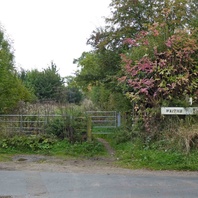
Viking Names
Waithe
Waithe, in the Haverstoe Wapentake of Lincolnshire, is thought to be originally derived from Old English (ge)wæd ‘a ford’. By the later twelfth century, the -d- was replaced by -th- either because of the Scandinavianization of the pronunciation, or by the replacement of (ge)wæd with its Old Norse cognate vað ‘a ford’. In both cases the meaning of the name is ‘at the ford’, which must be over Waithe Beck, where a minor road crosses the stream half a mile east of the church.
Read More
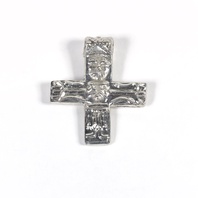
Viking Objects
Reproduction Crucifix Pendant
Crucifixes like this one would have been worn to display one’s faith and may have been a way for newly converted Scandinavians to be more accepted in society. By the late tenth to early eleventh centuries, assimilation would have seen many Scandinavians, both elites and common people, converted to Christianity and adopting Anglo-Saxon ways.
Read More

Viking Names
Sookholme
Sookholme, in the Bassetlaw Wapentake of Nottinghamshire, lies in a river valley and the etymology of the name reflects its location. The first element is Old English sulh ‘a plough; a ploughland (i.e. the amount of land which can be cultivated with one plough)’ which is combined with the second element, Old Norse holmr ‘an island, an inland promontory, raised ground in marsh, a river-meadow’. Thus it is a hybrid name with the probable meaning of ‘gully island’.
Read More

Viking Names
Kirkby Green
Kirkby Green, in the Langoe Wapentake of Lincolnshire, comes from the Old Norse appellative compound kirkju-by ‘a village with a church’. The affix Green come from Old English grene ‘grassy spot, a village green’
Read More
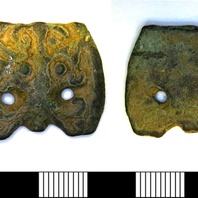
Viking Objects
Stirrup-Strap Mount (LEIC-7584A4)
This incomplete example of an Anglo-Scandinavian copper alloy stirrup-strap mount has the form of a Williams Class A mount and its decoration is similar to type 4.
Read More
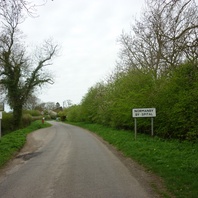
Viking Names
Normanby by Spital
Normanby by Spital, in the Aslacoe Wapentake of Lincolnshire, takes its name from the Old English ethnonym Norðman ‘Northman, Norwegian’ and the Old Norse element bý ‘a farmstead, a village’. A Domesday form of the name, Normanestouu, has as the second element Old English stow ‘a place, a place of assembly’, but this form is not supported by later recordings. The suffix Spital is for its proximity to Spittal in the Street, ‘hospital on a Roman road (Ermine Street)’. Traditionally, the place-name has been interpreted as referring to a settlement of Norwegians (in an area where most of the Scandinavian settlers were Danes). However, the exact implications of such a name are not yet fully understood and are the subject of ongoing work by Dr Jayne Carroll of the Institute for Name-Studies, University of Nottingham. There are other Normanbys in Lincolnshire, Normanby in Burton upon Stather and Normanby by Stow.
Read More
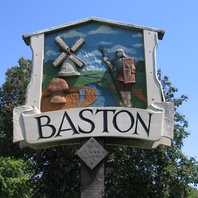
Viking Names
Baston
Baston, in the Ness Wapentake of Lincolnshire, is an Anglo-Scandinavian hybrid compound from the Old Norse male byname Bak meaning ‘back’ and the Old English element tun ‘an enclosure; a farmstead; a village; an estate’.
Read More

Viking Names
Ingus
Ingus is possibly an Anglo-Scandinavian formation because it is not attested in Scandinavia and perhaps only survives in the place-name Ings Beck, North Yorkshire. In the twelfth century the place-name was recorded as Ingusbec. The name is possibly a short form of the Old Norse female name Ingiríðr.
Read More
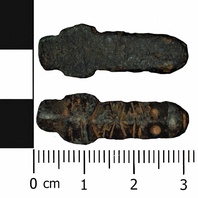
Viking Objects
Zoomorphic Strap-End (LANCUM-E11AB2)
This Thomas Class B, Type 4 strap-end has a pointed zoomorphic terminal moulded to represent an animal head with large semi-circular eyes and ears in Trewhiddle style. There are possible traces of niello in the recesses. .
Read More
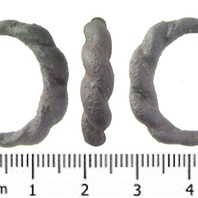
Viking Objects
Copper-Alloy Finger-Ring (SWYOR-AA27B1)
This copper-alloy finger-ring seems as if it was made from two strands of twisted wire, but could possibly have been cast. The ropework hoop may have been gilded. Even though similar designs are known from the Viking period, they were also used in other periods as well. Hence, the large date range.
Read More
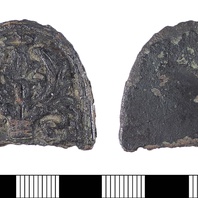
Viking Objects
Carolingian-Style Strap-End (LIN-9A2879)
It has been suggested this this strap-end came from a sword harness and, therefore, is classed as Thomas’s Class E, Type 1. The strap-end bears Carolingian-style relief decoration of a palmette set within a stylised plant with acanthus foliage and brush-like leaves. It does now show any evidence of gilding. Carolingian belt fittings from England could have been imported either indirectly through Scandinavia or directly from the Continent. It is possible that this strap end was brought over by Scandinavians as a result of their raids on the continent. Gabor Thomas suggests that the localisation of similar types of strap ends, known as Aspatria-type, in the Irish Sea region could indicate that they were worn by Scandinavian communities in that area.
